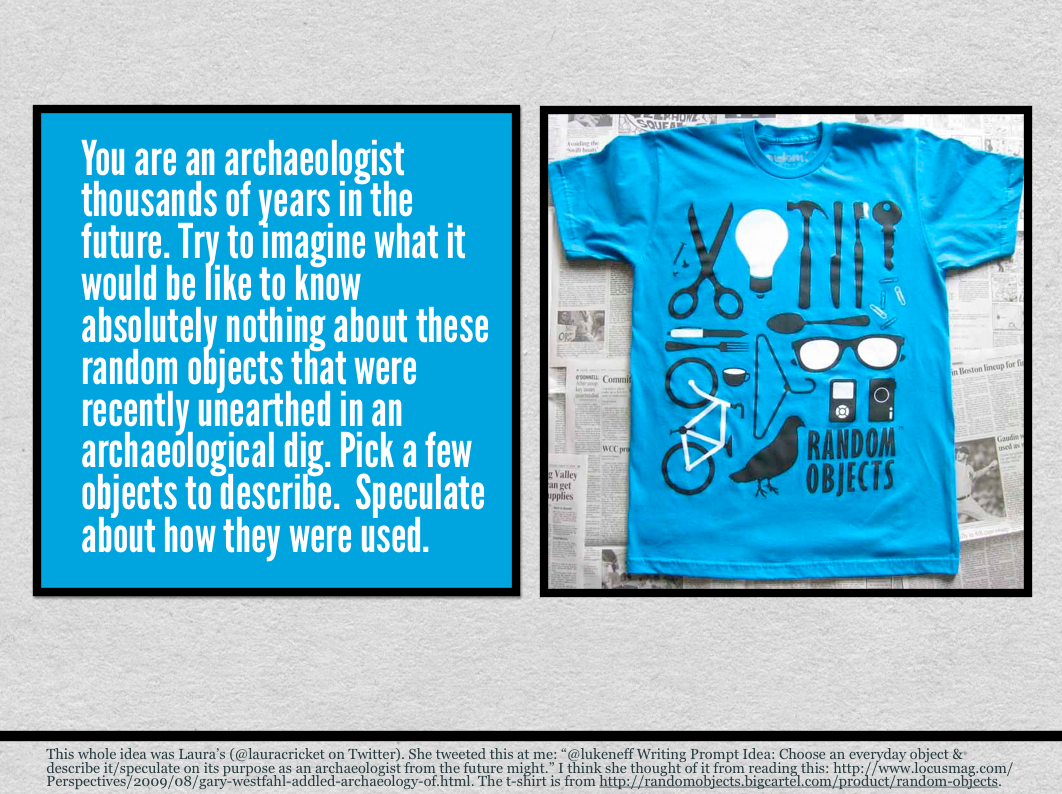One of my anthropology professors in college was always talking about buttons. “How many buttons in the room? What will future anthropologists make of these buttons? What significance will they assign to them: people wearing more buttons will perhaps be considered the highest of society while those wearing none the lowest...” that kind of thing. For this writing prompt to work, imagine that all I have are the pointy objects: the knife, maybe the spoon, the fork, pen, and key (and, sure, the toothbrush, if you want), in addition to the glasses and the scissors.
“This was obviously a very warlike society,” he began, sweeping his hand over the variety of objects lying before him. “But it was not a united communal battle, but a personal one, between only two of these prehistoric persons at a time. From the varied objects, we can easily infer that these private battles were very different depending on the individual.” He paused to tug on some gloves and picked up several objects. “We can see here that some were made for blunt force damage,” placing them delicately down, he picked up the next pair: “and some were merely to pierce,” making sure not to damage the ancient pieces as he replaced them, he picked up the final pair: “and some were clearly the result of a deranged mind hoping to inflict as much misery on an opponent as was possible.” He placed these final pieces back where they would be safe, cleared his throat, and continued.
“You may well be wondering how these small weapons could inflict any damage at all. The answer comes in the form of this ancient armor,” he said, indicating a rather larger object near the end of the table. “From the prevalence of armor like this, found in abundance at every site from this time period, scholars have found the relevance for these other objects. Quite simply,” he said, reaching for a nearby replica of the armor, “the reason that these small objects were so deadly is because they were meant to damage the ocular region.” He placed the replica on his own face, and tapped at the clear shield before his eyes. “These primitive people were so bent on their personal wars that their armor had to be both protective and transparent, so that they could guard their most vulnerable spot while still able to percieve their enemies.”
“This final piece,” he boomed out, as he removed the armor replica from his face and replaced it, “has been a point of contention in the academic community ever since it was unearthed.” He held up the final object, showing the audience many different angles. “It was first thought to be just another weapon, although deadlier, because of its dual edges, an individual could damage both ocular regions at the same time.” He let this sink in, then reversed his hold on the antiquated item, displaying the two round pieces on the other end. “The disagreement originates in the fact that this is attached to the same relic. The first party continues to insist that this article is a tool of war, and that this end was merely where it was grasped.” He demonstrated. “But there are those who cannot ignore the similarites between the non-lethal end and the archaic armor. For instance:” here he held the item up in front of his face, and the onlookers could all clearly see his eyes peering through the round pieces.
“The naysayers of this idea do not hesitate to point out the main difference between the round area on this piece and those of the different articles of armor that have been found is that this item does not have any protective covering; that is, if one tried to use this particular apparatus for both attack and defense, they would be leaving themselves undefended.”
“Some in this group insist that this was a weapon of high honor, given only to those who were the mightiest warriors, to taunt their foes. Those with this idea speculate that the warriors who wielded these weapons would not wear armor but would mock their opponent by holding the weapon to their eyes, and then striking when their adversary was within reach.”
“Still others see the lack of protective covering as a statement. They maintain that this weapon, deadly as it was, was not for any kind of skirmish at all but instead a symbol: that however one is armed or armored, all are equally vulnerable to death’s inevitable attack.”

No comments:
Post a Comment